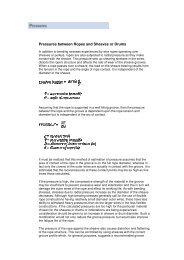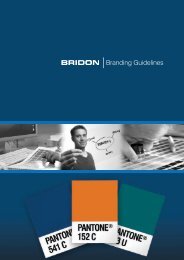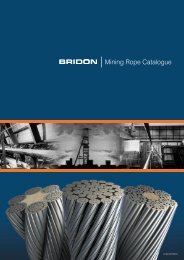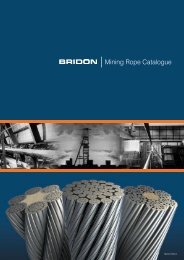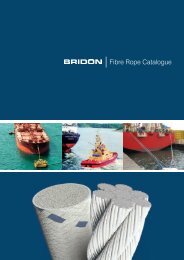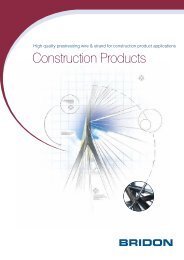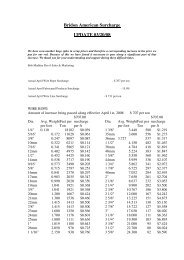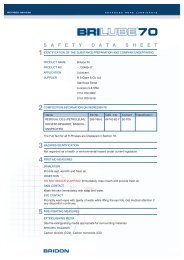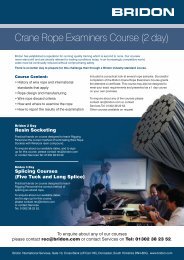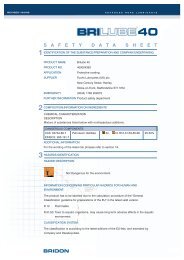High quality steel wire ropes for fishing applications - Bridon
High quality steel wire ropes for fishing applications - Bridon
High quality steel wire ropes for fishing applications - Bridon
You also want an ePaper? Increase the reach of your titles
YUMPU automatically turns print PDFs into web optimized ePapers that Google loves.
<strong>High</strong> <strong>quality</strong> <strong>steel</strong> <strong>wire</strong> <strong>ropes</strong> <strong>for</strong> <strong>fishing</strong> <strong>applications</strong>Fishing
<strong>High</strong> <strong>quality</strong> <strong>ropes</strong><strong>for</strong> the Fishing industry<strong>Bridon</strong> - the world’sleading specialist inthe manufacture of <strong>wire</strong>and rope solutions <strong>for</strong>the most demanding<strong>applications</strong>, deliveringreassurance throughunrivalled experience.Drawing from a background of long standingexperience and technology, <strong>Bridon</strong> is an acknowledgedworld leader in the design, manufacture, development andsupply of <strong>steel</strong> <strong>wire</strong> <strong>ropes</strong> to meet the needs of the <strong>fishing</strong> industry.The “Powercheck” symbol means that BRIDON has carried out adestruction test on a sample of rope from each production length.BRIDON has an active program to determine fatigue properties andspecifies material of specific dimensions and properties, which will enhancefatigue per<strong>for</strong>mance. BRIDON design and manufactures its <strong>ropes</strong> withfatigue in mind and has machines <strong>for</strong> fatigue testing crane <strong>ropes</strong>.02BRIDON Fishing
ContentsIntroduction ...................................... 2-3Trawl Warps and Purse Wires ..........4-5Technical In<strong>for</strong>mation......................6-11All statements, technical in<strong>for</strong>mation and recommendationscontained herein are believed to be reliable, but no guarantee isgiven as to their accuracy and/or completeness. The user mustdetermine the suitability of the product <strong>for</strong> his own particularpurpose, either alone or in combination with other products andshall assume all risk and liability in connection therewith.Whilst every attempt has been made to ensure accuracy in thecontent of the tables, the in<strong>for</strong>mation contained in this cataloguedoes not <strong>for</strong>m part of any contract.<strong>Bridon</strong>’s products are manufactured undercontrols that con<strong>for</strong>m to <strong>quality</strong>management system ISO 9001:2000.ISO 14001<strong>Bridon</strong> operates environmentalmanagement systems which, whererequired by legislation or risk, comply withthe requirements of EN ISO 14001:2004and are assessed and registered byaccredited certification bodies.BRIDON Fishing03
Trawl Warps and Purse WiresDYFORM ®<strong>High</strong> strength and proven extended ropelife - preventing core corrosion and maintaining design diameter.6x26 (10/5&5/5/1)Poly CorePoly Core6x26 (10/5&5/5/1)IWRCSteel CoreDiameterWeightMinimum breaking loadDiameterWeightMinimum breaking loadmmKg/100mtrTonneskNmmKg/100mtrTonneskN161820222426283032343638404244103.3129.1159.7191.7224.8271.5317.4357.3408.8468.2514.5578.6635.2700.3768.517.121.626.732.338.545.152.460.168.477.286.696.4106.9117.8129.3168212262317377443514590671757849946104811551268161820222426283032343638404244115.5145.3183216.6254.7307.2351.7403.8461.1527.2599.4661.1725.4799.383819.124.129.836.042.950.358.467.076.286.096.5107.5119.1131.3144.11872372923534204935726577488449461054116812881413DYFORM ®<strong>High</strong> strength - smooth periphery <strong>for</strong> reduced pulley wear.6x26 (10/5&5/5/1)Poly CorePoly Core6x26 (10/5&5/5/1)IWRCSteel CoreDiameterWeightMinimum breaking loadDiameterWeightMinimum breaking loadmmKg/100mtrTonneskNmmKg/100mtrTonneskN161820222426283032343638404244103.3129.1159.7191.7224.8271.5317.4357.3408.8468.2514.5578.6635.2700.3768.517.121.626.732.338.545.152.460.168.477.286.696.4106.9117.8129.3168212262317377443514590671757849946104811551268161820222426283032343638404244115.5145.3183216.6254.7307.2351.7403.8461.1527.2599.4661.1725.4799.383819.124.129.836.042.950.358.467.076.286.096.5107.5119.1131.3144.11872372923534204935726577488449461054116812881413Figures shown are <strong>for</strong> guidance purposes only. For details specific to your requirement please contact <strong>Bridon</strong>04BRIDON Fishing
Trawl Warps and Purse WiresDYFORM ®Specially designed purse <strong>wire</strong>s with large outer <strong>wire</strong>s <strong>for</strong> increased abrasion resistanceand a smooth surfacesuitable <strong>for</strong> purse rings.6x19 (9/9/1)Poly Core6x26 (10/5&5/5/1)Poly CorePoly CorePoly CoreDiameterWeightMinimum breaking loadDiameterWeightMinimum breaking loadmmKg/100mtrTonneskNmmKg/100mtrTonneskN202224262830160.2192.7231.1269.1310.5358.526.532.138.244.852.059.7260315374439510585202224262830159.7191.7224.8271.5317.4357.326.732.338.545.152.460.1262317377443514590Large outer <strong>wire</strong>s <strong>for</strong> increased wear and abrasion resistance.6x19 (9/9/1)Poly Core6x19 (9/9/1)IWRCPoly CoreSteel CoreDiameterWeightMinimum breaking loadDiameterWeightMinimum breaking loadmmKg/100mtrTonneskNmmKg/100mtrTonneskN1618202224262728303290.9116.8144.2175.1205.4241.4261.8279.2315.637014.918.823.228.133.539.342.445.652.359.514618522827632838541644751358416182022242627283032102128.9164.6199.7235.4276.9294.9318.9383.241116.120.325.130.436.142.445.749.256.464.2157199246298354416448482554630Proven design <strong>for</strong> all Beam Trawling <strong>applications</strong>.6x26 (10/5&5/5/1)Poly CorePoly Core6x26 (10/5&5/5/1)IWRCSteel CoreDiameterWeightMinimum breaking loadDiameterWeightMinimum breaking loadmmKg/100mtrTonneskNmmKg/100mtrTonneskN222426283032174.4202.9240.6280.7324.6362.625.730.535.841.647.754.3252300352408468532222426283032199.4236.5276.2320.5369.741527.632.938.644.851.458.5271323379439504573BRIDON Fishing05
Technical In<strong>for</strong>mationProduct Safety: Instructions and Warningson the use of <strong>steel</strong> <strong>wire</strong> ropeThe following Instructions and Warnings combine to <strong>for</strong>mguidance on Product Safety and are intended <strong>for</strong> use bythose with a working knowledge of <strong>wire</strong> as well as the newuser. They should be read, followed and passed on toothers.Failure to read, understand and follow these instructionscould result in harmful and damaging consequences.A “Warning ” statement indicates a potential hazardoussituation which could result in a significant reduction in ropeper<strong>for</strong>mance and/or put at risk, either directly or indirectly,the safety or health of those persons within the dangerzone of the rope and its associated equipment.STORAGEUnwrap the rope and examine immediately after delivery toverify that it is in accordance with the details on deliverydocuments.Measurement of rope diameter should be carried out asshown in Fig 1.Select a clean, well ventilated, dry area <strong>for</strong> storage, coverwith waterproof material if conditions preclude insideFig 1.storage. Rotate the reel periodically during long periods ofstorage, particularly in warm environments, to preventmigration of lubricant from the rope.Warning Never store <strong>wire</strong> rope in areas subject toelevated temperatures as this may seriously affect its futureper<strong>for</strong>mance. In extreme cases its original as-manufacturedstrength may be severely reduced rendering it unfit <strong>for</strong> safeuseSupport the reel clear of the floor so that there is a clearpassage of air under the reel. Ensure that the rope is storedwhere it is not likely to be affected by chemical fumes,steam or other corrosive agents.supervised by a competent person. Suitable protectiveclothing and equipment should be worn.Warning Incorrectly supervised handling andinstallation procedures may result in serious injury topersons in the vicinity of the operation as well as thosedirectly involved in the process.Be<strong>for</strong>e InstallationExamine the rope visually to ensure that no damage ordeterioration has occurred during storage or transportation.Check the working area <strong>for</strong> potential hazards that mayaffect the safe installation of the rope. Check the conditionof the rope related equipment on the vessel. Include thefollowing:DrumCheck the general condition of the winch drum to ensurethat it is in good condition with no damage or areas that willcause damage to the rope.Sheaves (Pulleys)Ensure that the groove is the correct shape and size <strong>for</strong> thenew rope. Check that sheaves are free to rotate and ingood condition. When a new rope is fitted a variation in sizecompared with the old worn rope will be apparent. The newrope may not fit correctly into the previously worn grooveprofile and unnecessary wear and rope damage may occur.This may be remedied by machining out the grooves be<strong>for</strong>ethe new rope is fitted. Be<strong>for</strong>e this is done care should betaken to ensure that sufficient material is present tomaintain strength in the sheave after machining.StructureEnsure that no part of the vessel’s <strong>steel</strong>work is positionedsuch that it will lie in the path of the rope between theinstallation drum and winchWarning Failure to carry out any of the above couldresult in unsatisfactory and unsafe rope per<strong>for</strong>mance.InstallationInstallation of the rope should be carried out in the followingmanner:Pass a shaft through the reel and place the reel in asuitable stand that allows it to rotate and be braked toavoid overrun during installation. The rope must betransferred from reel to winch drum in the correct manner,top to top or bottom to bottom. Fig 2Warning Failure to do so may result in the ropebecoming contaminated with <strong>for</strong>eign matter and start theonset of corrosion be<strong>for</strong>e the rope is put to work.Ensure the rope is stored and protected in such a way thatit will not be exposed to accidental damage either duringstorage or in placing the rope into or taking it out ofstorage.HANDLING AND INSTALLATIONFig 2.06Handling and installation of the rope should be carried outin accordance with a detailed plan and should beBRIDON Fishing
Technical In<strong>for</strong>mationThe reel stand should be positioned to maintain amaximum fleet angle of 1.5 degrees. Correct blockalignment and control of fleet angle is essential to avoidinducing “turn” in the rope Fig 3Fig 5.Fig 3.Warning Failure to carry out this procedure will allowmovement and crushing of the rope on the drum.Smaller VesselsThe direction of coiling on the drum is important and shouldbe related to the direction of lay of the rope to ensure closecoiling. The correct method of locating the rope anchoragepoint on the winch drum is shown in Fig 4Smaller vessels with simple winch systems and shorterrope lengths may install <strong>ropes</strong> using a braked reel, go tosea shoot the gear and use the tension generated toachieve good spooling. NB Twin rigged vessels with threedrums on one shaft must ensure that all three <strong>ropes</strong> areinstalled and tensioned simultaneously to avoid spoolingirregularities.Ensure that the outboard end of the rope is released fromthe reel in a controlled manner. On release of the bindingsused <strong>for</strong> packaging the rope will want to straighten, unlesscontrolled this could be a violent action. Stand clear.WarningFailure to control could result in injuryFig 4.Care must be taken to avoid free end rotation of the ropeend, which may cause un-laying or elongation.Warning Any looseness or uneven winding will resultin excessive wear, crushing and distortion ofthe rope.Ensure that the as-manufactured condition of the rope ismaintained throughout the whole of the handling andinstallation operation.Warning Irregular coiling usually results in severesurface wear and rope mal<strong>for</strong>mation, which in turn is likelyto cause premature rope failureLarger VesselsFor larger vessels with auto trawl systems and longer ropelengths the rope must be installed under as much tensionas is safe and practical to ensure that the “under layers”are wound tightly on the drum. <strong>Bridon</strong> would recommendapplying 5-10% of the M.B.L of the rope as back tension,when installing the rope onto the winch. A suitablyanchored spooling machine may be used. Fig 5Take particular care when the rope has to be cut. Applysecure servings on both sides of the cut mark using <strong>wire</strong>orstrong twine. Each serving should be at least two ropediameters. Arrange and position the rope in such amanner that when cut the rope ends will remain inposition, avoiding any backlash or other undesirablemovement. Fig 6Warning Rope produced from carbon <strong>steel</strong> <strong>wire</strong>s inthe <strong>for</strong>m shipped is not considered a health hazard. Duringsubsequent processing (e.g.cutting, grinding andFig 6.cleaning) dust and fumesmay be produced whichcontain elements which mayaffect exposed workers.Ideally cut the rope with anabrasive disc cutter, othersuitable mechanical andhydraulic shearingequipment may be used ifnecessary. Ensure adequateventilation during cutting toavoid any build up of fumesfrom the rope or any of itsconstituents.Warning Somespecial <strong>ropes</strong> containsynthetic material which,d = rope diameterwhen heated totemperatures above normal processing temperatures maydecompose and give off toxic fumes.BRIDON Fishing07
Technical In<strong>for</strong>mationTroubleshooting GuideTypical examples of Wire Rope deterioration1 Mechanical damage9 Typical <strong>wire</strong> fracturesdue to rope movementas a result of bendover sharp edgefatigue.projection whilst underload.2 Localised wear due to10 Wire fractures at theabrasion on supportingstrand, or corestructure.interface, as distinctfrom ‘crown’ fractures.3 Narrow path of wear11 Break up of IWRCresulting in fatigueresulting from highfractures, caused bystress application.working in a grosslyoversize groove, orover small supportrollers.4 Two parallel paths of12 Looped <strong>wire</strong>s as abroken <strong>wire</strong>s indicativeresult of torsionalof bending through animbalance and/or shockundersize groove in theloading.sheave.5 Severe wear,13 Typical example ofassociated with highlocalised wear andtread pressure.de<strong>for</strong>mation.6 Severe wear in Lang’s14 Multi strand rope ‘birdLay, caused bycaged’ due to torsionalabrasion.imbalance.7 Severe corrosion.15 Protrusion of ropecentre resulting frombuild up of turn.8 Internal corrosion16 Substantial wear andwhilst external surfacesevere internalshows little evidence ofcorrosion.deterioration.08BRIDON Fishing
Technical In<strong>for</strong>mationTroubleshooting GuideThe following is a simplified guide to common <strong>wire</strong> rope problems. More detailed advice can be obtained from any <strong>Bridon</strong>distributor. In the event of no other standard being applicable, <strong>Bridon</strong> recommends that <strong>ropes</strong> are inspected/examined inaccordance with ISO 4309.ProblemMechanical damage caused by the rope contacting thestructure of the installation on which it is operating or anexternal structure - usually of a localised nature.Cause/Action•Generally results from operational conditions.•Check sheave guards and support/guide sheaves toensure that the rope has not “jumped out” of theintended reeving system.•Review operating conditions.Opening of strands in rotation resistant, low rotation andparallel closed <strong>ropes</strong> - in extreme circumstances the ropemay develop a “birdcage distortion” or protrusion of innerstrands.Note - rotation resistant and low rotation <strong>ropes</strong> are designedwith a specific strand gap which may be apparent ondelivery in an off tension condition. These gaps will closeunder load and will have no effect on the operationalper<strong>for</strong>mance of the rope.•Check sheave and drum groove radii using sheavegauge to ensure that they are no smaller than nominalrope radius +5% - <strong>Bridon</strong> recommends that the sheaveand drum groove radii are checked prior to any ropeinstallation.•Repair or replace drum/sheaves if necessary.•Check fleet angles in the reeving system - a fleet anglein excess of 1.5 degrees may cause distortion.•Check installation method - turn induced duringinstallation can cause excessive rope rotation resultingin distortion.•Check if the rope has been cut “on site “ prior toinstallation or cut to remove a damaged portion fromthe end of the rope. If so, was the correct cuttingprocedure used? Incorrect cutting of rotation resistant,low rotation and parallel closed <strong>ropes</strong> can causedistortion in operation.•Rope may have experienced a shock load.Broken <strong>wire</strong>s or crushed or flattened rope on lower layersat crossover points in multi - layer coiling situations.Wire breaks usually resulting from crushing or abrasion.•Check tension on underlying layers. <strong>Bridon</strong>recommends an installation tension of between 2% and10% of the minimum breaking <strong>for</strong>ce of the <strong>wire</strong> rope.Care should be taken to ensure that tension is retainedin service. Insufficient tension will result in these lowerlayers being more prone to crushing damage.•Review <strong>wire</strong> rope construction. Dy<strong>for</strong>m <strong>wire</strong> <strong>ropes</strong> aremore resistant to crushing on underlying layers thanconventional rope constructions.•Do not use more rope than necessary.•Check drum diameter. Insufficient bending ratioincreases tread pressure.Wires looping from strands.•Insufficient service dressing.•Consider alternative rope construction.•If <strong>wire</strong>s are looping out of the rope underneath acrossover point, there may be insufficient tension on thelower wraps on the drum.•Check <strong>for</strong> areas of rope crushing or distortion.BRIDON Fishing09
Technical In<strong>for</strong>mationTroubleshooting GuideProblem“Pigtail” or severe spiralling in rope.Cause/Action•Check that the sheave and drum diameter is largeenough - <strong>Bridon</strong> recommends a minimum ratio of thedrum/sheave to nominal rope diameter of 18:1.•Indicates that the rope has run over a small radius orsharp edge.•Check to see if the rope has “jumped off” a sheave andhas run over a shaft.Two single axial lines of broken <strong>wire</strong>s running along thelength of the rope approximately 120 degrees apartindicating that the rope is being “nipped” in a tightsheave.•Check sheave and drum groove radii using sheavegauge to ensure that they are no smaller than nominalrope radius + 5% - <strong>Bridon</strong> would recommend that thesheave/drum groove radii are checked prior to anyrope installation.•Repair or replace drum/sheaves if necessary.One line of broken <strong>wire</strong>s running along the length of therope indicating insufficient support <strong>for</strong> the rope, generallycaused by oversize sheave or drum grooving.•Check to see if the groove diameter is no greater than15% greater than the nominal rope diameter.•Repair or replace drum/sheaves if necessary.•Check <strong>for</strong> contact damage.Short rope life resulting from evenly/randomly distributedbend fatigue <strong>wire</strong> breaks caused by bending through thereeving system.Fatique induced <strong>wire</strong> breaks are characterised by flatends on the broken <strong>wire</strong>s.•Bending fatigue is accelerated as the load increasesand as the bending radius decreases. Consider whethereither factor can be improved.•Check <strong>wire</strong> rope construction - Dy<strong>for</strong>m <strong>ropes</strong> arecapable of doubling the bending fatigue life of aconventional <strong>steel</strong> <strong>wire</strong> rope.Short rope life resulting from localised bend fatigue <strong>wire</strong>breaks.Fatique induced <strong>wire</strong> breaks are characterised by flatends on the broken <strong>wire</strong>s.•Bending fatigue is accelerated as the load increasesand as the bending radius decreases. Consider whethereither factor can be improved.•Check <strong>wire</strong> rope construction - Dy<strong>for</strong>m <strong>ropes</strong> arecapable of doubling the bending fatigue life of aconventional <strong>steel</strong> <strong>wire</strong> rope.•Localised fatigue breaks indicate continuous repetitivebends over a short length. Consider whether it iseconomic to periodically shorten the rope in order tomove the rope through the system and progressivelyexpose fresh rope to the severe bending zone. In orderto facilitate this procedure it may be necessary to beginoperating with a slightly longer length of rope.10BRIDON Fishing
Technical In<strong>for</strong>mationTroubleshooting GuideProblemCore protrusion or broken core in single layer six or eightstrand rope.Cause/Action•Caused by repetitive shock loading - reviewoperating conditions.Rope accumulating or “stacking” at drum flange - due toinsufficient fleet angle.•Review drum design with original equipmentmanufacturer - consider adding rope kicker, fleetingsheave etc.Sunken wraps of rope on the drum normally associatedwith insufficient support from lower layers of rope orgrooving.•Check correct rope diameter.•If grooved drum check groove pitch.•Check tension on underlying layers - <strong>Bridon</strong> recommendan installation tension of between 2% and 10% of theminimum breaking <strong>for</strong>ce of the <strong>wire</strong> rope - Care shouldbe taken to ensure that tension is retained in service.Insufficient tension will result in these lower layers beingmore prone to crushing damage.•Make sure that the correct rope length is being used.Too much rope (which may not be necessary) mayaggravate the problem.Short rope life induced by excessive wear and abrasion.•Check fleet angle to drum.•Check general alignment of sheaves in the reevingsystem.•Check that all sheaves are free to rotate.•Review rope selection. The smooth surface of Dy<strong>for</strong>m<strong>wire</strong> <strong>ropes</strong> gives better contact with drum and sheavesand offers improved resistance to “interference”betweeen adjacent laps of rope.External corrosion.•Consider selection of galvanised rope.•Review level and type of service dressing.Internal corrosion.•Consider selection of galvanised rope.•Review frequency amount and type of service dressing.•Consider selection of plastic impregnated (PI) <strong>wire</strong> rope.BRIDON Fishing11
Balby Carr Bank, Doncaster, South YorkshireDN4 5JQ United KingdomPhone: +44(0) 1302 565100Fax: +44(0) 1302 565190Email: <strong>fishing</strong>@bridon.comwww.bridon.comWhen you have finished withthis brochure please recycle itEdition 3



